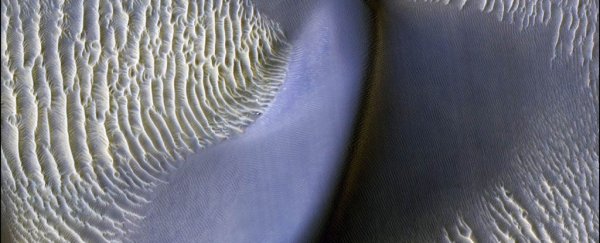For the first time, scientists have observed that 'megaripples' on Mars – huge sand waves seen on the Martian surface – are moving structures, and not ancient relics stuck in place since the Red Planet's distant past.
Megaripples, which also occur in deserts on Earth, are generally larger than smaller sand ripples, and are composed of chunkier, coarser sand grains that sit at the top of their crests, resting on finer grains buried at the bottom.
The heftiness of the crest grains – combined with the very thin and faint winds of Mars' light atmosphere today – had scientists thinking these sediment structures must be static and immovable formations. Not so, new research shows.
A study led by planetary scientist Simone Silvestro from the INAF Capodimonte Astronomical Observatory in Italy reveals Martian megaripples are a flowing phenomenon after all – although you have to watch very, very closely to catch them in the act.
By comparing images taken by the HiRISE camera (High Resolution Imaging Experiment) on NASA's MARS Reconnaissance Orbiter over the space of several years, Silvestro's team discovered the Martin megaripples are definitely in motion, just a very slow motion.
Between 2007 and 2016, megaripples at two Martian sites – Nili Fossae and McLaughlin crater – shifted at average speeds as low as 12 centimetres (4.7 inches) a year, with a top recorded speed of 19 centimetres (7.5 inches) per year.
At such slow rates of displacement, it's perhaps no wonder these shifting sands were thought to be static – and previous comparisons examining the formations over shorter timeframes of only two to three Martian years had failed to detect the subtle migration. Now, thankfully, we have more probe data to draw upon, affording a closer look at what's happening.
"We had the opportunity to see these megaripples moving because now we have more than 10 years of observations," Silvestro explained to Inside Science.
It's not just our probe imagery that's expanded, however. So too has our understanding of what's possible in the Martian atmosphere, as before this, researchers didn't think Mars' winds would be powerful enough within the thin atmosphere to move the megaripples – which are so large that they were spaced up to 35 metres (115 ft) apart in the areas studied here (although the average is about 5 metres, or 16 ft).
It seems the Martian wind can move the megaripples, provided it has some help. The researchers suggest the proximity of larger sand dunes located in the Nili Fossae and McLaughlin crater areas studied could be helping to shift the megaripples, with the finer-grained dunes providing a high volume of sand flux that may help displace the coarse grains sitting atop the megaripple crests.
Without such a level of "impact-driven creep" from neighbouring, saltating dunes, other Martian megaripples might not be able to move so much, nor as quickly as the speedy bunch glimpsed here.
While these megaripples may be slow, though, the fact that we can see them moving at all doesn't only represent a significant increase in our knowledge of atmospheric conditions on Mars – it's also just some very impressive science at work.
As planetary scientist Ralph Lorenz from Johns Hopkins University, who was not involved in the research, told Science: "We can now measure processes on the surface of another planet that are just a couple times faster than our hair grows."
The findings are reported in the Journal of Geophysical Research: Planets.
